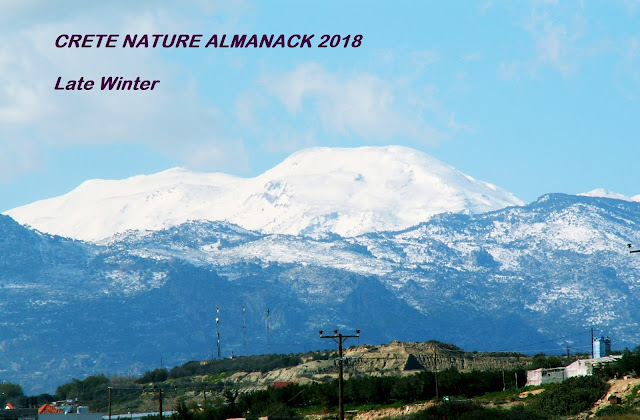A
little break as we wind towards the end of our East Crete Upland
Village Tour. This week sees the true midwinter between the Winter
Solstice and the Spring Equinox. This is the coldest part of the year
here in Crete (as it is in the rest of the northern hemisphere) so I
thought I'd compile a little list of some of the things to look out
for in the coming weeks. February 1st was long considered
the beginning of the year before Julius Ceasar got his hands on the
calendar and it is still celebrated as such in the Pagan wheel of the
year as Imbolc. A time for resolutions (in case your January 1st
ones have gone by the board) and for starting the spring cleaning
(watch out for the Greek version: Clean Monday on February 19th
which is a national holiday). Or if all that sounds a bit onerous why
not have a midwinter party instead and celebrate the oncoming warmer
weather?
Flowers
Cretan
Sowbread, Cyclamen creticum
This
is a lovely little Cyclamen endemic to Crete, where it is widespread,
as well as to a couple of locations on Karpathos. Look for it in damp rocky
places, such as winter stream gullies, growing in the shade. Keep an
eye out also for Iris
unguicularis,
Almond
trees coming into flower (Prunus
dulcis)
and the first appearance of Cretan
Ebony (Ebenus
cretica).
Insects
Pine
Processionary Caterpillars, Thaumetopoea
pityocampa
These
are they guys that make the pine trees look as though they are
hoarding candyfloss in their branches. They will be leaving their
nests in the next few weeks and heading down to the ground, nose to
tail, in long columns where they will pupate in the earth, emerging
as adult moths in late spring or early summer. Late winter is also
a good time to watch for migratory moths taking advantage of the
warmer temperatures here in the south. Look out too for the Oil
Beetle, Meloe tuccius foraging about in the grasslands, looking as though he is wearing some other beetle's wing cases that are a few sizes too small for him.
Reptiles
& Amphibians
Green Toad spawn,
Bufotes viridis
Time to be
children again and collect a bit of toad spawn. If you haven't got a
pond in your garden yet then build one and stock it with a few of
these long strands (toads lay spawn in strings, frogs lay spawn in
clumps). Not only do they provide hours of interest for all ages as
they develop into tadpoles and then toads but as adults they are
particularly adept at mollusc management in the garden. Whilst you
are out collecting try a bit of rock flipping to look for hibernating
Ocellated
Bronze Skinks, Chalcides
ocellatus,
or maybe, if you're exceptionally lucky, a Leopard
Snake, Zamenis
situla.
Birds
Goldfinch,
Carduelis carduelis
Although
the Goldfinch is resident all year round here in Crete their numbers
are swollen considerably at this time as they migrate down from the
colder areas of northern Europe to visit their cousins for a winter
warm up. With less vegetation about at this time of year they are
also considerably easier to spot. This is also a good time of year to
visit your local reservoir as a great variety of waterfowl visit
Crete in the winter.
Next
week it's back to the tour and I've found an interesting clearing in
a pine wood to the west of Agios Stefanos that is just itching to be
investigated.
*********************************************************************
LINKS:
Share
your nature thoughts, photos and comments on Naturalists
(the
facebook page that accompanies this blog)
Explore
the region with the #CreteNature interactive Hiking
and Nature Map




















